画个电池
当然,电池充电,首先得用 CSS 画一个电池,这个不难,随便整一个:

欧了,勉强就是它了。有了电池,那接下来直接充电吧。最最简单的动画,那应该是用色彩把整个电池灌满即可。
方法很多,代码也很简单,直接看效果:
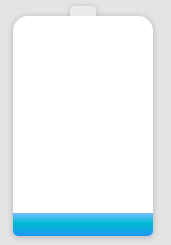
有内味了,如果要求不高,这个勉强也就能够交差了。通过蓝色渐变表示电量,通过色块的位移动画实现充电的动画。但是总感觉少了点什么。
<div class="container">
<div class="battery"></div>
</div>
html,
body {
width: 100%;
height: 100%;
display: flex;
background: #e4e4e4;
}
.container {
position: relative;
width: 140px;
margin: auto;
}
.battery {
height: 220px;
box-sizing: border-box;
border-radius: 15px 15px 5px 5px;
filter: drop-shadow(0 1px 3px rgba(0,0,0,0.22));
background: #fff;
z-index: 1;
&::before {
content: "";
position: absolute;
width: 26px;
height: 10px;
left: 50%;
top: 0;
transform: translate(-50%, -10px);
border-radius: 5px 5px 0 0;
background: rgba(240, 240, 240, .88);
}
&::after {
content: "";
position: absolute;
left: 0;
right: 0;
bottom: 0;
top: 90%;
background: linear-gradient(to bottom, #7abcff 0%, #00BCD4 44%, #2196F3 100%);
border-radius: 0px 0px 5px 5px;
box-shadow: 0 14px 28px rgba(33, 150, 243, 0), 0 10px 10px rgba(9, 188, 215, 0.08);
animation: charging 6s linear infinite;
filter: hue-rotate(90deg);
}
}
@keyframes charging {
50% {
box-shadow: 0 14px 28px rgba(0, 150, 136, 0.83), 0px 4px 10px rgba(9, 188, 215, 0.4);
}
95% {
top: 5%;
filter: hue-rotate(0deg);
border-radius: 0 0 5px 5px;
box-shadow: 0 14px 28px rgba(4, 188, 213, .2), 0 10px 10px rgba(9, 188, 215, 0.08);
}
100% {
top: 0%;
filter: hue-rotate(0deg);
border-radius: 15px 15px 5px 5px;
box-shadow: 0 14px 28px rgba(4, 188, 213, 0), 0 10px 10px rgba(9, 188, 215, 0.4);
}
}增加阴影及颜色的变化
如果要继续优化的话,需要添加点细节。
我们知道,低电量时,电量通常表示为红色,高电量时表示为绿色。再给整个色块添加点阴影的变化,呼吸的感觉,让充电的效果看起来确实是在动。
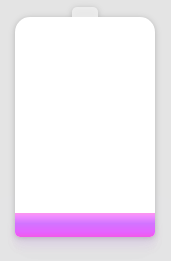
知识点
到这里,其实只有一个知识点:
- 使用 filter: hue-rotate() 对渐变色彩进行色彩过渡变换动画
我们无法对一个渐变色直接进行 animation ,这里通过滤镜对色相进行调整,从而实现了渐变色的变换动画。
上述例子完整的 Demo: CodePen Demo -- Battery Animation One
添加波浪
ok,刚刚算一个小里程碑,接下来再进一步。电量的顶部为一条直线有点呆呆的感觉,这里我们进行改造一下,如果能将顶部直线,改为波浪滚动,效果会更为逼真一点。
改造之后的效果:
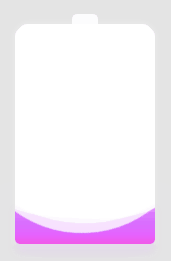
使用 CSS 实现这种波浪滚动效果,其实只是用了一种障眼法,具体的可以我早期写的这篇文章:
纯 CSS 实现波浪效果!
知识点
这里的一个知识点就是上述说的使用 CSS 实现简易的波浪效果,通过障眼法实现,看看图就明白了:
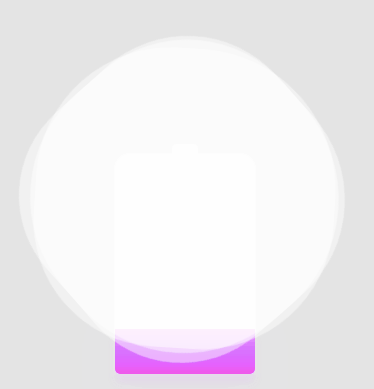
上述例子完整的 Demo: CodePen Demo -- Battery Animation Two
<div class="container">
<div class="header"></div>
<div class="battery">
</div>
<div class="battery-copy">
<div class="g-wave"></div>
<div class="g-wave"></div>
<div class="g-wave"></div>
</div>
</div>
html,
body {
width: 100%;
height: 100%;
display: flex;
background: #e4e4e4;
}
.container {
position: relative;
width: 140px;
margin: auto;
}
.header {
position: absolute;
width: 26px;
height: 10px;
left: 50%;
top: 0;
transform: translate(-50%, -10px);
border-radius: 5px 5px 0 0;
background: rgba(255, 255, 255, .88);
}
.battery-copy {
position: absolute;
top: 0;
left: 0;
height: 220px;
width: 140px;
border-radius: 15px 15px 5px 5px;
overflow: hidden;
}
.battery {
position: relative;
height: 220px;
box-sizing: border-box;
border-radius: 15px 15px 5px 5px;
box-shadow: 0 0 5px 2px rgba(255, 255, 255, 0.22);
background: #fff;
z-index: 1;
&::after {
content: "";
position: absolute;
left: 0;
right: 0;
bottom: 0;
top: 80%;
background: linear-gradient(to bottom, #7abcff 0%, #00BCD4 44%, #2196F3 100%);
border-radius: 0px 0px 5px 5px;
box-shadow: 0 14px 28px rgba(33, 150, 243, 0), 0 10px 10px rgba(9, 188, 215, 0.08);
animation: charging 10s linear infinite;
filter: hue-rotate(90deg);
}
}
.g-wave {
position: absolute;
width: 300px;
height: 300px;
background: rgba(255, 255, 255, .8);
border-radius: 45% 47% 44% 42%;
bottom: 25px;
left: 50%;
transform: translate(-50%, 0);
z-index: 1;
animation: move 10s linear infinite;
}
.g-wave:nth-child(2) {
border-radius: 38% 46% 43% 47%;
transform: translate(-50%, 0) rotate(-135deg);
}
.g-wave:nth-child(3) {
border-radius: 42% 46% 37% 40%;
transform: translate(-50%, 0) rotate(135deg);
}
@keyframes charging {
50% {
box-shadow: 0 14px 28px rgba(0, 150, 136, 0.83), 0px 4px 10px rgba(9, 188, 215, 0.4);
}
95% {
top: 5%;
filter: hue-rotate(0deg);
border-radius: 0 0 5px 5px;
box-shadow: 0 14px 28px rgba(4, 188, 213, .2), 0 10px 10px rgba(9, 188, 215, 0.08);
}
100% {
top: 0%;
filter: hue-rotate(0deg);
border-radius: 15px 15px 5px 5px;
box-shadow: 0 14px 28px rgba(4, 188, 213, 0), 0 10px 10px rgba(9, 188, 215, 0.4);
}
}
@keyframes move {
100% {
transform: translate(-50%, -160px) rotate(720deg);
}
}OK,到这,上述效果加上数字变化已经算是一个比较不错的效果了。当然上面的效果看上去还是很 CSS 的,就是一眼看到就觉得用 CSS 是可以做到的。
使用强大的 CSS 滤镜实现安卓充电动画效果
那下面这个呢?

用安卓手机的同学肯定不陌生,这个是安卓手机在充电的时候的效果。看到这个我就很好奇,使用 CSS 能做到吗?
经过一番尝试,发现使用 CSS 也是可以很好的模拟这种动画效果:
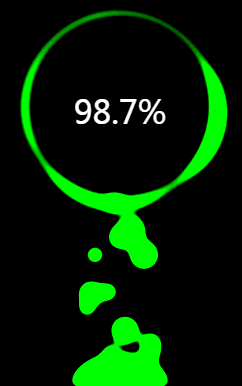
上述 Gif 录制的效果图是完全使用 CSS 模拟的效果。
上述例子完整的 Demo: HuaWei Battery Charging Animation
<div class="g-container">
<div class="g-number">98.7%</div>
<div class="g-contrast">
<div class="g-circle"></div>
<ul class="g-bubbles">
<li></li>
<li></li>
<li></li>
<li></li>
<li></li>
<li></li>
<li></li>
<li></li>
<li></li>
<li></li>
<li></li>
<li></li>
<li></li>
<li></li>
<li></li>
</ul>
</div>
</div>
html,
body {
width: 100%;
height: 100%;
display: flex;
background: #000;
overflow: hidden;
}
.g-number {
position: absolute;
width: 300px;
top: 27%;
text-align: center;
font-size: 32px;
z-index: 10;
color: #fff;
}
.g-container {
position: relative;
width: 300px;
height: 400px;
margin: auto;
}
.g-contrast {
filter: contrast(10) hue-rotate(0);
width: 300px;
height: 400px;
background-color: #000;
overflow: hidden;
animation: hueRotate 10s infinite linear;
}
.g-circle {
position: relative;
width: 300px;
height: 300px;
box-sizing: border-box;
filter: blur(8px);
&::after {
content: "";
position: absolute;
top: 40%;
left: 50%;
transform: translate(-50%, -50%) rotate(0);
width: 200px;
height: 200px;
background-color: #00ff6f;
border-radius: 42% 38% 62% 49% / 45%;
animation: rotate 10s infinite linear;
}
&::before {
content: "";
position: absolute;
width: 176px;
height: 176px;
top: 40%;
left: 50%;
transform: translate(-50%, -50%);
border-radius: 50%;
background-color: #000;
z-index: 10;
}
}
.g-bubbles {
position: absolute;
left: 50%;
bottom: 0;
width: 100px;
height: 40px;
transform: translate(-50%, 0);
border-radius: 100px 100px 0 0;
background-color: #00ff6f;
filter: blur(5px);
}
li {
position: absolute;
border-radius: 50%;
background: #00ff6f;
}
@for $i from 0 through 15 {
li:nth-child(#{$i}) {
$width: 15 + random(15) + px;
left: 15 + random(70) + px;
top: 50%;
transform: translate(-50%, -50%);
width: $width;
height: $width;
animation: moveToTop #{random(6) + 3}s ease-in-out -#{random(5000)/1000}s infinite;
}
}
@keyframes rotate {
50% {
border-radius: 45% / 42% 38% 58% 49%;
}
100% {
transform: translate(-50%, -50%) rotate(720deg);
}
}
@keyframes moveToTop {
90% {
opacity: 1;
}
100% {
opacity: .1;
transform: translate(-50%, -180px);
}
}
@keyframes hueRotate {
100% {
filter: contrast(15) hue-rotate(360deg);
}
}知识点
拆解一下知识点,最主要的其实是用到了 filter: contrast() 以及 filter: blur() 这两个滤镜,可以很好的实现这种融合效果。
单独将两个滤镜拿出来,它们的作用分别是:
-
filter: blur(): 给图像设置高斯模糊效果。 -
filter: contrast(): 调整图像的对比度。
但是,当他们“合体”的时候,产生了奇妙的融合现象。
先来看一个简单的例子:

仔细看两圆相交的过程,在边与边接触的时候,会产生一种边界融合的效果,通过对比度滤镜把高斯模糊的模糊边缘给干掉,利用高斯模糊实现融合效果。
当然,这种效果在之前的文章也多次提及过,更具体的,可以看看:
颜色的变换
当然,这里也是可以加上颜色的变换,效果也很不错:
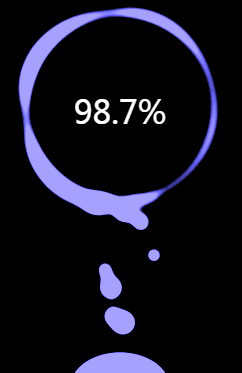
上述例子完整的 Demo: HuaWei Battery Charging Animation
容易忽视的点
通过调节 filter: blur() 及 filter: contrast() 属性的值,动画效果其实会有很大程度的变化,好的效果需要不断的调试。当然,经验在其中也是发挥了很重要的作用,说到底还是要多尝试。
最后
本文给出的几个充电动画,效果渐进增强,本文只指出了最核心的知识点。但是在实际输出的过程中有很多小细节是本文没有提及的,感兴趣的同学还是应该点进 Demo 好好看看源码或者自己动手实现一遍。
更多精彩 CSS 技术文章汇总在我的 Github -- iCSS ,持续更新,欢迎点个 star 订阅收藏。





















